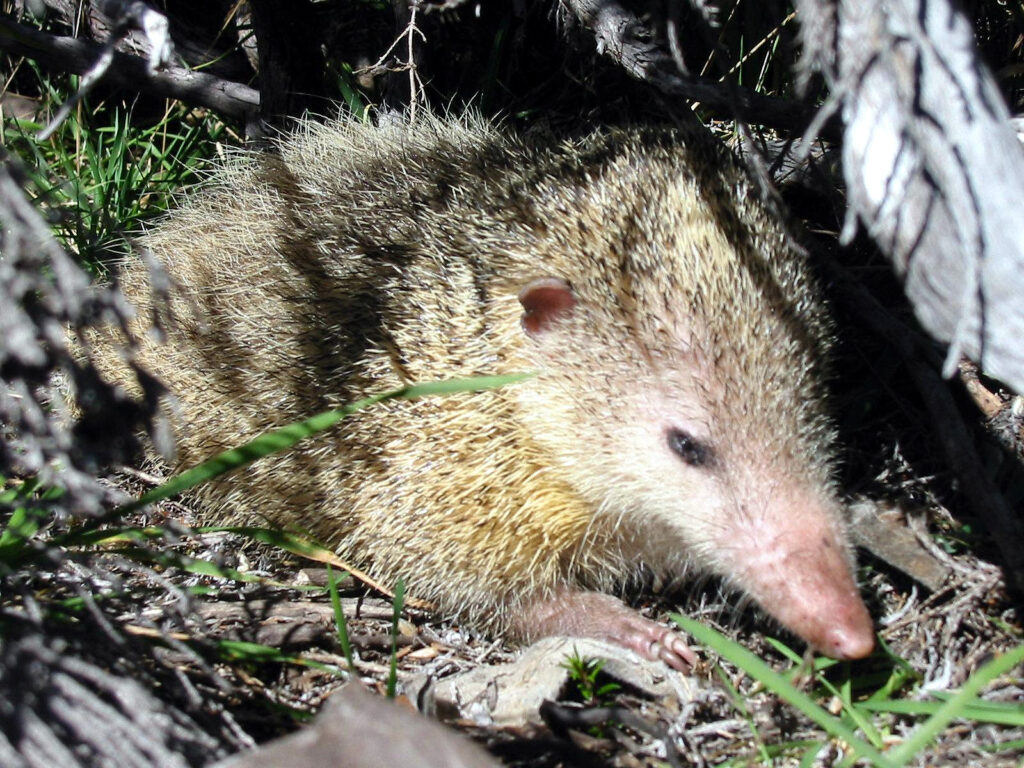If you cannot find the answer you are looking for, please contact us.
Common tenrec

First described in 1778 by Schreber, the Common Tenrec is unique among its relatives for being the largest tenrec species and capable of giving birth to extraordinarily large litters, even up to 32 young at once.
Taxonomy
| Kingdom: | Animalia |
| Phylum: | Chordata |
| Class: | Mammalia |
| Order: | Afrosoricida |
| Suborder: | Tenrecomorpha |
| Family: | Tenrecidae |
| Subfamily: | Tenrecinae |
| Genus: | Tenrec |
| Species: | Tenrec ecaudatus |
Natural range & habitat
The Common Tenrec is endemic to Madagascar and also established in the Comoro Islands, Réunion, Mauritius, and Seychelles through human introduction. It inhabits a wide variety of environments, from moist lowland and montane forests to dry shrubland, savanna, agricultural fields, gardens, and urban areas. This adaptability makes it one of the most widespread and versatile tenrec species.
Physical traits
This is the largest tenrec, reaching up to 26–39 cm in length and weighing between 1.5 and 2.5 kg. It has coarse fur interspersed with long, sharp spines, a short tail (about 1–1.5 cm), and a pointed snout with long whiskers. When threatened, it erects its spines, makes a loud cry, leaps, bucks, and may bite. The young initially display striking black-and-white striping.
Behavior & lifestyle
The Common Tenrec is primarily nocturnal and solitary, except during mating season. It spends the daylight hours resting in nests made from vegetation, which are often hidden under logs, rocks, or within dense shrubbery. This tenrec is remarkably adaptable and can thrive in both wild and human-altered landscapes. During the dry season, it may enter an extended period of hibernation, sometimes lasting up to nine months, retreating into a burrow to conserve energy. Its foraging is mostly done by rooting through soil and leaf litter with its highly sensitive snout. Although mainly terrestrial, it is a competent digger and can also swim. In colder months, its activity drops significantly, and in highland areas, it is known to survive harsh seasonal conditions through deep torpor.
Communication
This species uses a surprisingly rich range of communication methods for a solitary mammal. They produce high-pitched squeaks, grunts, and hissing sounds when disturbed or alarmed. Young tenrecs are capable of stridulation, producing ultrasonic sounds by rubbing bristles together, which may serve as alarm calls or a way to maintain contact with siblings. Adults rely heavily on chemical communication: they drag their cloaca across the ground to mark their presence and territory. Tactile signals are also important, especially during mating or defensive encounters. While their vision is poor, their acute sense of smell and touch helps guide their social interactions.
Diet in the wild
Common Tenrecs are omnivorous, feeding on soil invertebrates (especially larvae of beetles, ants, termites), small vertebrates (such as frogs, reptiles, small mammals), fruit, leaves, carrion, and even bird eggs. They forage by probing the soil and logs with their long snout, using sensitive whiskers to locate prey.
Reproduction & life cycle
They are extremely fecund: after a gestation of 50–64 days, females may give birth to litters of 12–20 pups, occasionally up to 32. Newborns are striped and grow rapidly—eyes open around one week, independency by two months, and females may begin breeding during the same season they were born.
Threats & conservation status
The IUCN categorizes the Common Tenrec as Least Concern, given its wide distribution and ecological adaptability. While populations are generally stable, ongoing deforestation, land conversion, and hunting in some areas may pose localized threats. It thrives in many protected landscapes across Madagascar.
This species in captivity
Occasionally kept as a pet in Madagascar and rarely imported into Europe, they are difficult to care for in captivity due to their high metabolic rate and specialized omnivorous diet requiring frequent feeding on varied live prey and vegetation. Captured individuals are rarely sustained long‑term, and standardized husbandry protocols are essentially nonexistent.
